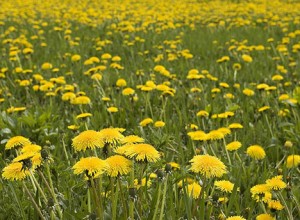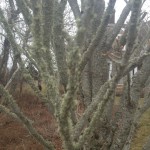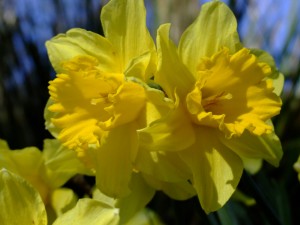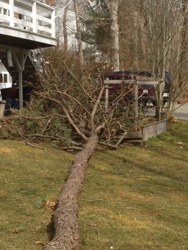
Dandelions are pretty but not in your lawn.
Finally, the landscape is finally awash with color. But not all the color is welcome. Dandelions are popping up everywhere. A customer called this week and was concerned that our first treatment didn’t work. I assured her it had done exactly what it was meant to do- fertilize her lawn but that also means it helped along anything that was hungry for food and warm temperatures which didn’t make an appearance until well into April. Our spring lawn treatment contains a pre-emergent crab grass control. This product only stops the germination of crabgrass. Broadleaf weeds, like dandelions are not treated until they are actively growing. This method allows us to spot spray only where it is needed and not blanket your lawn with product. If you are a customer seeing a sea of gold in your yard- and it’s not loose change from a leprechaun’s pot, give us a call. Customers know, service calls are always free!
]]>every year- that is ten times as many as previously reported. Some medical professionals fear this epidemic is more widespread than AIDS and without greater awareness, more destructive.
Lyme disease is not easily diagnosed. Most people assume that without an attached tick or bullseye rash, Lyme does not exist. Below is a link to a series of short essays written by a doctor who is victim of late stage, undiagnosed Lyme disease.
Dr. Jon Sterngold Late Stage Lyme Diagnosis
The best way to beat Lyme and other tick borne illnesses is prevention. Here are some tips:
- Tall grass is a great hiding spot for small animals that carry deer ticks. These animals travel through leaf litter and carry deer ticks to your yard. Keep grass around foundations, trees, fences and structures trimmed.
- Clean up debris from around your property. Leaf litter is a haven for ticks.
- Tick checks-often times ticks hitch a ride into your home on your pet. They fall off and often times a person becomes the new host.
- The Greenskeeper offers a variety of solutions for tick control. Tick control is a great way to diminish tick populations and help to make your home safer for your pets and family.
Call today for pricing.
]]>
How can you not like the look of lichens?
Do you like lichens?
We recently received a phone call from a customer that her tree was being invaded by some wild fuzzy creatures. She said, My tree looks like it is from outerspace with hairy green appendages all over it.’ What was growing on her trees were lichen. Lichen, are an unusual pair. Yes, pair. One part fungus one part algae the two live in harmony, each doing a job to keep the organism alive. The alga, a microscopic green plant, makes food for the pair while the fungus, a non green plant supports and provides moisture. Lichen do not harm trees. They are squatters, hanging onto the branches and trunks of trees for support. Lichen are good indicators of air quality. They can withstand extreme heat and cold but perish in polluted conditions. They also work as air filters. Like other green plants, they use carbon dioxide for photosynthesis. Beside being air purifiers, lichen are used for a number of other purposes such as dyes, medicine and food. They are also sold for decorative purposes. For $12 you can buy a bag of them at Pottery Barn and use them as a vase filler. Or save yourself the $12 and pick them yourself. There seems to be an abundance of them all over Cape Cod and the South Shore.
Remember, healthy trees make for healthy air. If you have trees or shrubs that you would like to preserve the health and longevity of, call your Greenskeeper for a free consultation.
Last year many areas were spared from Winter Moth Caterpillars. According to UMass Extension, the numbers could be significantly higher than last year. It is unclear how the extreme cold temperatures will affect the numbers that hatch. While winter moth are historically cold tolerant, temperatures this year were extreme and may help to keep the numbers down. Regardless, your Greenskeeper is ready for them. If you see the start of activity in your area, give us a call. These pests are unpredictable and in recent years we have seen activity in very specific pockets. One neighborhood could be inundated while a few streets over there was no activity.
]]>
Who has spring fever?
Last week’s storm was Mother Nature’s wake up call to us all. Here at the Greenskeeper, we had enough. The day before the storm was spent raking, cleaning up branches and burning. Sure we knew that the lawn would be covered again but that little bit of warm weather had given us spring fever.
If you are itching to get out, here are a few things you can do to get ready for spring.
1. Lightly rake your lawn to remove twigs and debris and fluff up the turf to promote growth. Don’t rake too vigorously or you run the risk of pulling out viable dormant grass.
2. Remove any brown perennial foliage from garden plants that you were not able to remove last fall.
3. Trim back ornamental grasses.
4. Edge borders.
5. Look for emerging bulbs!
6. Cut some forsythia and bring it in and force it. Springtime in a vase!
Whatever gets you through the final days of March, go for it. Your Greenskeeper will see you soon!
]]>Tree/Shrub Insect Disease Control: Insects are still active and fungal diseases are a problem this time of year. A treatment in fall will make for healthier plants in spring.
Fall Dormant Oil: Smothers egg masses to prevent insects from hatching in spring. This is especially helpful for insects like winter moths.
Antidessicants: Cold biting winds dry out landscape plants. Antidessicants form a barrier to prevent wind burn on landscape plants.
Deep Root Fertilization: We recommend 2 deep root feedings per year. The spring feeding will promote new growth. A fall deep root feeding benefits root development and the overall health of your plants.
We also get asked quite often about pruning. It is not a service we offer but a good rule of thumb is to wait until your deciduous trees and shrubs (those that lose foliage in winter) are dormant until you do any pruning. In fall these plants are very susceptible to fungal diseases and slow healing wounds are excellent entrance points for those diseases. Also pruning when plants aren’t dormant promotes growth and the new growth will not survive cold winter temperatures.
]]>Trees are not only an important part of the beauty of our landscape but they are vital to our ecosystem. They provide oxygen for all living things and a habitat for animals. Some produce fruit or nuts which are important food sources for both humans and animals. But what happens when the tree itself becomes the food source? Without proper treatment, pests can severely compromise the vitality of trees. Pests that might not kill a tree can weaken it enough that secondary pathogens will. These threats can also spread to and infect healthy trees. It’s an ongoing cycle. Property damage and personal injury are a risk as compromised trees are more susceptible to dropping limbs or being blown over or uprooted by adverse weather. Three pests of immediate concern for trees in our region are Winter Moth Caterpillar, Hemlock Wooly Adelgid and The Turpentine Beetle.
Winter Moth Caterpillar: It starts with moths in flight in late fall and early winter. In early spring, your car is covered with pin head sized pellets, the air smells like a litter box and when you walk through your yard, it’s like walking through cob webs. Then you see the culprit, that all too familiar nasty green inchworm. Like many invasive species the Winter Moth is not native to the US. Its origins can be traced back to Europe, where due to numerous natural predators and parasites, its affects were never as devastating as they have been in the northeast United States. After multiple years of attacks from not only winter moth but forest tent caterpillars and gypsy moth in the mid 2000’s, excessive defoliation is taking its toll and many deciduous trees (primarily oak) are showing signs of serious decline. Many trees have died in southeastern Massachusettsover the last 3 years from the stress of this defoliation coupled with drought and other factors. Multiple years of defoliation weakens trees to the point where secondary agents, also known as “weak invaders” can overcome what is left of a tree’s natural defenses, killing the tree. Scientists are experiencing great success in controlling the population, through the use of a natural predator Cyzenis Albicans but Winter Moth persists and scientists are predicting severe defoliation in pockets in pockets in 2012. To combat winter moth early spring horticultural oil is an excellent practice. By coating egg masses before they hatch, population is decreased. A follow up treatment to control populations that did hatch or migrated via wind and rain is suggested a short time later.
Hemlock Wooly Adelgid: This sucking insect was first identified in Massachusettslandscapes in 1988 having spread from an already existing infestation in Connecticut. Wooly Adelgid feeds on the hemlock by sucking sap from the twigs of the host plant. Already compromised trees die within 3 to 5 years of infestation. Healthy trees can live longer. This insect is atypical as it is very active through the winter and fairly inactive during the growing season. The pest is easily identified in its adult stage as it resembles cottonballs on the underside of hemlock needles. Without treatment, mortality is certain.
Black Turpentine Beetle: This pest is one of the most common and serious threats to Japanese Black Pine and Pitch Pine in coastal areas of the Northeast. Pitch pines, which are known for being very tolerant of salt spray and harsh conditions, are being especially hard hit on Cape Cod. Weakened trees emit a pheromone that attracts bark beetles. The beetles chew through the trunk of the already weakened plant to the vascular area, making the pitch flow out. Once that pitch hardens, the beetles re enter and once again, pitch flows out forming a pitch tube. This continues until the all the resin is drained from the tree. The beetles generally colonize trees in the first 8 feet of the trunk so the tell tale holes and pitch tubes are easily identified and something homeowners should be scouting for. It is important for homeowners to removed dead or diseased trees from their property to be less attractive to these invasive beetles and avoid the hazards of falling trees and limbs.
The Greenskeeper Lawn, Tree & Shrub can identify and treat for insects and diseases that are a threat to the health of your trees. Treatment is more environmentally friendly and less costly than removal and replacement of dead and diseased trees. If you think you might have damage from any of these insects or are concerned about the health of your trees, call The Greenskeeper Lawn, Tree & Shrub Service. Our knowledgeable staff will identify pests and present a plan that will have you enjoying your great outdoors for years to come.
]]>
During a regular vet visit, our beloved yellow lab Mojo was diagnosed with Lyme disease. We were surprised and heartbroken. We regularly used Frontline or Advantix, had Mojo groomed, did tick checks and even had him immunized. At home, we follow appropriate cultural practices and even treat our property for tick infestation. But we also enjoy nature walks in our own neighborhood along rural roads and around cranberry bogs – both havens for tick activity. Fortunately, we caught the disease before he was symptomatic but the reality is as “pet parents” we feel responsible. By raising your tick IQ, taking appropriate precautions and preventative measures you can diminish exposure to Lyme and other tick borne illnesses.
Deer and dog ticks over winter and are currently very active. People and pets are susceptible to the diseases some of which can mean dire consequences. The best way to deal with ticks is by preventing them from biting. Ticks are often hitchhikers- brought to your yard by other animals that travel through leaf litter in wooded areas. While most people associate deer ticks, with the presence of deer, more often rabbits, squirrels, mice and other animals that travel low to the ground are the real culprits. As a matter of fact, scientists are predicting a boom in Lyme cases in 2012 and are basing this, believe it or not, on the lack of acorns in 2011 and the affect on the white footed mouse population. There are steps you can take to make sure you are safe in your yard and home from tick bites.
1. Mow: Ticks thrive in tall grass where they can find hosts to latch onto. By keeping your grass short, you are creating an inhospitable environment. Be sure to weed whack tall grass around foundations, trees, fences and structures. These are great runways and hiding spots for small animals that carry ticks.
2. Clean Up Your Act: Clean up debris on the lawn and the perimeter of your property. That dumping spot for grass clippings and leaves is a haven for ticks. Keep things neat and tidy with a separate area for composting.
3. Tick Checks: Do a tick check once a day. Many people are under the impression that topical products that they apply on pets monthly will prevent ticks altogether. This is not true and often, a tick hitches a ride on a person or pet and is then roaming free in your home.
4. Treatments: The Greenskeeper Lawn, Tree & Shrub Service has new, animal friendly products to deter, tick carrying animals from your property. These products, used in conjunction with our tick spray service will significantly lessen the likelihood of ticks on your property.
]]>
